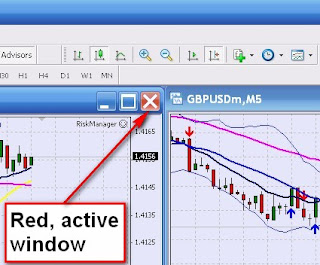For every window opened, there will be 3 possible main actions as shown by the 3 icons in the right hand top corner of the window. They are in order from left to right, Minimize, Maximize/Restore Down and Close. The Restore Down icon will appear if the window is already maximized (i.e. in full screen) and the Maximize icon will appear if the window can be manipulated, usually not in full screen.

When a Window is maximized, it will fill the whole screen. To restore to previous size (or Restore Down) click the middle icon and the window will restore to its previous size for you to manipulate the window as you cannot manipulate a window that is Maximised. You can drag the window to a new position by placing your cursor on the top title bar and holding down your left mouse button. By putting your cursor at the sides of the window, it will change into a double headed arrow and you can adjust the size by dragging the edge in either direction of the arrow while holding down the left mouse button. This will work on any of the four sides of the window.
When you press the Minimize icon, the window will disappear and appear as a tab in the bottom task bar or at the bottom of the program window. Click on the tab and it will open that window again. But if you Close the window by clicking the X icon, the window will be closed and removed and it cannot be reopened again.
We can open multiple windows in any one session. How do we use this in Metatrader 4? You can create many charts or windows on one screen and by adjusting the sizes of these windows, you can arrange them in any configurations, such as side by side, one on top of another, in a 2 x 2 formation and so on. It is really up to you and how you want to see the information comfortably. For example, you may want to have an overview of the market by having a chart each of EURUSD, GBPUSD, USDCHF and USDJPY place in a 2 x 2 formation. Or to have a detail look at just the EURUSD market simultaneously by having 3 charts of this pair at different time frame side by side. You can also just have one chart of EURUSD and change the timeframe accordingly as desired but this is not the same as looking at 3 timeframes at once. Once you have your charts in the formation that you want, you can then save them as a new Profile and recall the different Profiles the next time you open Metatrader 4.
Bear in mind that though you can see several windows at once, only one window is active at any one time and any action taken will apply only to that window. The active window is indicated by a red background in the Close or X icon.
In the case of Metatrader 4, the active window will also have its tab shown in white background among the rest that are in grey. Click on any of the grey tab and it will turn white and that window will become the active window. Alternatively, you can just click on any opened window that is visible and it will become the active window.
While at Metatrader 4, sometimes your active window or chart is maximize and fills the whole available space and there is no window icon visible. Do not worry, look at the extreme top left corner of Metatrader menu bar and you will see a Window Menu icon.
Click on this and the drop down Window Menu will appear and you can select Restore to bring all the windows from the Maximized mode to the Restore Down mode. While the windows are in Restore Down mode, that Window Menu icon will not appear. Once you maximize one window, all the rest of the windows will also be maximized and you select each window by clicking on its tab at the bottom of the window. Conversely, once you Restore Down one window, all the windows will be restored to their previous sizes.
When you add indicators to a main Metatrader 4 chart, many of them will appear separately in a sub-window below the main chart and these are part of the main window. Their heights can be adjusted by placing the cursor at any of the boundaries and dragging it up or down.
At times in Metatrader 4, you may find that a window has gone to far down and you cannot access the bottom edge of a window to bring it up (to reduce the height). What you can do is to reduce the height from the top, then adjust the window position and finally access the bottom edge when it becomes visible.
Once you master these basic window skills, you will be able to manipulate the charts to your advantage by having all the information that you need for better trading. Have fun and happy trading.
Ronald Kwok
http://cbpirate.com/s/cbp/ronaldkwok











